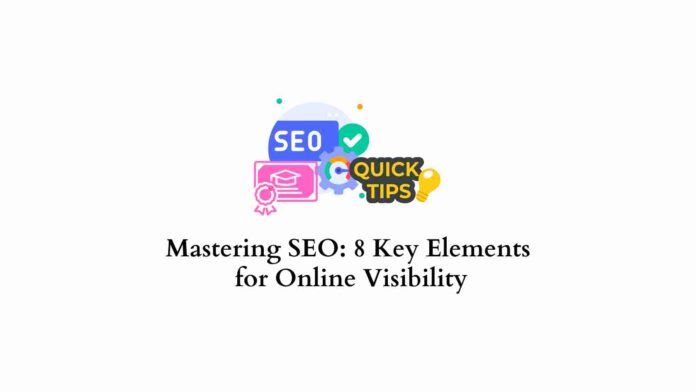Last updated - November 22, 2023
It is not wrong here to state that everything that an online business aspires to or has dreamt of starts with a higher rank on the SERP. You might agree with this, don’t you? A top rank provides you with online visibility, which then brings traffic to your website and a chance of converting that traffic into a paying customer.
All the steps discussed here require an intervention of SEO key elements that make the visitors take the desired action. To tell you the truth here, SEO is not simply an application of tips and tricks but rather a well-thought-out process that has helped many acquire the success they had dreamt of.
eCommerce websites that you shop from also need eCommerce SEO services to become visible to their target audience. In this article, you shall learn about the eight key SEO elements that are sure to bring online visibility to your business in need.
Link Building
Link building translates to acquiring backlinks from a third-party website that directs the visitors to your own website. Backlinks are nothing but hypertext which, when clicked, directs a visitor to another web page or website. Simple, right? But the question that remains is how does it help? Well, to start, know that backlinks are seen as a ranking factor by Google. This is enough to put an emphasis on the need for Backlinks in your SEO strategy. Some of the benefits that backlinks provide to a website are as follows:
- Increased Website Visibility: When a third-party website likes your website, Google sees it as a vote of confidence. This vote serves as an indicator of your website’s quality and relevance. As a result of which, your website is more likely to rank higher on the SERP, which eventually increases the website’s visibility.
- Improved Organic Traffic: The very aim of Backlink is to generate organic traffic. When a user on another website clicks on a backlink and lands on your website, it generates traffic. The more backlinks your website has, the more the chance for visitors to discover and land on your website.
- Faster Indexing and Crawling: Backlinks help Google to discover and index web pages. When search engine bots crawl the web, they follow from one page to another. If your website has backlinks from a good authority website, the chances are high for your target web pages to get discovered and indexed.
- Social Proof and Brand Building: When some reputable website links back to you, it signals the users that the website is of value. This acts as a form of social proof that positively influences the decision-making process of the visitor.
Website Speed:


It denotes the time that a website takes to fully load or serve a user’s request. When it comes to ranking on Google’s SERP, the speed of a website is detrimental. How, you may ask? This is where the concept of bounce rates comes into play.
The bounce rate is the percentage of people leaving your website. From the “website speed” point of view, a slow-loading website has a higher percentage of bounce rate. You should know here that it is very bad for SEO success.
A website that loads fast is sure to engage the visitors, which in turn helps to increase the dwell time of the users visiting your website. Dwell time is the total time users spend on your website, which signals to Google that the website is of relevance and value. This, in turn, helps Google to rank your website higher on its SERP.
12 Ways How You Can Increase the Speed of Your Website
- Optimize image size and format.
- Enable browser caching.
- Minify CSS, JavaScript, and HTML.
- Enable GZIP compression.
- Optimize CSS delivery.
- Reduce HTTP requests.
- Implement lazy loading.
- Optimize server response time.
- Minimize redirects.
- Enable a content delivery network (CDN).
- Remove unnecessary plugins and scripts.
- Monitor and optimize website performance.
Local SEO:
Local SEO, as the name suggests, is the process of optimizing your website for local searches. It is a well-known fact that not every business online serves or has the resources to serve a wide geographical area. This aspect or element of SEO is here to ease the competition that small businesses face from large ones.
For Example, You want to treat your family with nice Thai Cuisine. But you do not know any places around your location. It is natural that you will type something like this “ Nice Thai restaurants near me ” This prompt to search engines such as Google will show you the local business listing around you. By doing so, you have beaten the competition that bigger restaurants pose and brought your restaurants to the top of the SERP with the help of Local SEO.
Ways How You Can Optimize for Local SEO.
- Create and optimize a Google My Business listing.
- Ensure consistent NAP (Name, Address, Phone Number) information across all online directories.
- Use local keywords in your website’s meta tags, titles, and content.
- Encourage and respond to customer reviews on platforms like Google, Yelp, and industry-specific directories.
- Create location-specific landing pages or content to target different geographical areas.
Quality Content
Content is the soul of any digital marketing strategy. There is no one who does not regard content as the most important element in an SEO strategy. Quality content is defined as “written text that is not only informational in nature but also is relevant to the users’ search query.” Does your content align with the informational and relevance part of the definition? Well, if not, you should seriously think about it.
The most tricky part of quality content is the relevant part which you need to refine or embody with target keywords. If you have just started, you can leverage Google’s suggestion or the People also asked or related searches section. You can also try your hands on Google Trends to filter the keywords that are in trends and incorporate those in your landing pages or blogs.
Internal Links


These are hyperlinks that make visitors jump from one web page of a website to another. Internal links provide a proper structure to your website that, in turn, helps Google to discover and index your new web pages. They also provide value to visitors who want to know more about related topics in a single click. To establish that internal links are a crucial factor in ranking, consider a case study.
| Company X had a website with proper site architecture and many orphan pages. No matter how much effort they put into their SEO strategies, they were not able to see a ranking success. One day they thought to sort out all the mess that their website was. They started interlinking related web pages to each other to have a proper site structure. You will not believe it, but in a few days, their website reached the first page of the Google SERP. Amazing right? This is the power of internal links that one should leverage to feature at the top of the SERP. |
Also, internal links help to pass some authority to a new web page when you link a ranking or authoritative web page. This helps to improve the ranking potential of your web page.
Responsive Design
Responsive design is an approach by which your website will be equally accessible across different websites. The concept of responsive design came forth with the increase in the use of mobile by users to surf the internet. You might be surprised to know that “58.99% of all website traffic worldwide comes from mobile phones,” So it becomes essential for websites to optimize for responsive design to serve the different screen needs of the users.
The benefits of responsive design are as follows.
- Improved user experience across devices.
- Increased mobile traffic and engagement.
- One website for all devices (desktop, mobile, tablet).
- Cost-effective and time-efficient compared to maintaining separate websites for different devices.
- Higher search engine rankings due to mobile-friendliness being a ranking factor.
- Better conversion rates and lower bounce rates.
- Consistent branding and messaging across devices.
- Easier website management and updates.
- Enhanced website loading speed and performance.
- Future-proofing your website for new devices and screen sizes.
URL structure
The structure of a URL tells users which web page they are currently on. It is not purely beneficial for navigational purposes only but also helps Google understand the context of your website.
For Example.
- Bad URL Format: www.seoexperts.com/56343537/hdd
- Good URL Format: www.seoexperts.com/blogs/Mastering SEO: 8 Key Elements for Online Visibility
It is pretty evident from the above two examples that a good URL that is SEO optimized is easy to understand and navigate.
Note: With respect to this format, you should also make sure that your URL structure contains the target keyword that aligns with your business online.
Meta text
It is an umbrella term for Meta Titles and Meta Descriptions. You might not know this, but meta text plays a crucial role in SEO success.
Meta title: Also known as page title, It is a tag that appears on the SERP. When you search for some topic online, the title of the web page that you see is a meta title. Google sees Meta Titles as a ranking factor. It helps users, as well as search engines, understand the context of your web or landing pages.
Meta Description: It is a short summary of your web page that appears below the Meta Title. It is not a ranking factor for Google, but it provides the context of the web page to users and search engines alike.
Final Words!!
In conclusion, SEO is the solution for the less visibility of websites today. By implementing the above key SEO elements, you can bring your website to the top of the search engine result pages.











